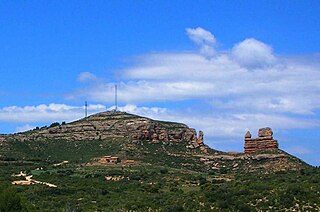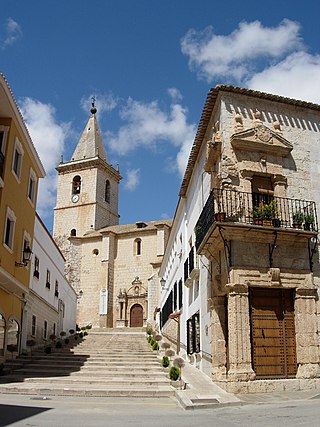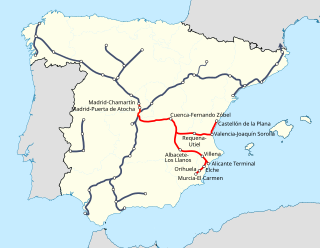
Murcia is a city in south-eastern Spain, the capital and most populous city of the autonomous community of the Region of Murcia, and the seventh largest city in the country. It had a population of 460,349 inhabitants in 2021. The total population of the metropolitan area was 672,773 in 2020, covering an urban area of 1,230.9 km2. It is located on the Segura River, in the southeast of the Iberian Peninsula. It has a climate with hot summers, mild winters, and relatively low precipitation.

Teruel is a province of Aragon, in the northeast of Spain. The capital is Teruel.

Ferdinand IV of Castile called the Summoned, was King of Castile and León from 1295 until his death.

Cuenca is a city and municipality of Spain located in the autonomous community of Castilla–La Mancha. It is the capital of the province of Cuenca.

Albacete is a city and municipality in the Spanish autonomous community of Castilla–La Mancha, and capital of the province of Albacete.

Villena is a city in Spain, in the Valencian Community. It is located at the northwest part of Alicante, and borders to the west with Castilla-La Mancha and Murcia, to the north with the province of Valencia and to the east and south with the province of Alicante. It is the capital of the comarca of the Alto Vinalopó. The municipality has an area of 345.6 km² and a population of 34,144 inhabitants as of INE 2023.

Don Juan Manuel was a Spanish medieval writer, nephew of Alfonso X of Castile, son of Manuel of Castile and Beatrice of Savoy. He inherited from his father the great Lordship of Villena, receiving the titles of Lord, Duke and lastly Prince of Villena. He married three times, choosing his wives for political and economic convenience, and worked to match his children with partners associated with royalty. Juan Manuel became one of the richest and most powerful men of his time, coining his own currency as the kings did. During his life, he was criticised for choosing literature as his vocation, an activity thought inferior for a nobleman of such prestige.

Alcantarilla is a town and municipality in southeastern Spain, in the Autonomous Community of the Region of Murcia. The town is only 7 km away from the capital of the region, the city of Murcia, and one of its peculiarities is that it is completely surrounded by "pedanías" of the municipality of Murcia like Sangonera La Seca, San Ginés, Nonduermas, Puebla de Soto, La Ñora, Javalí Viejo and Javalí Nuevo.

La Roda is a Spanish municipality located in the Province of Albacete, within the autonomous community of Castilla-La Mancha. It is situated along the A-31 highway and has a population of 15,527 inhabitants. The town is known for its pastry known as miguelitos. It is part of the La Mancha region of Albacete.

Lope de Barrientos (1382–1469), sometimes called Obispo Barrientos, was a powerful clergyman and statesman of the Crown of Castile during the 15th century, although his prominence and the influence he wielded during his lifetime is not a subject of common study in Spanish history.

Trasmoz is a village in the province of Zaragoza, Aragon, Spain, with an estimated population of 96.

Salinas del Manzano is a city of Spain in the province of Cuenca in the autonomous community of Castile-La Mancha. It has an area of 33.65 km2 with population of 105 inhabitants and a population density of 3.21 inhabitants / km2.

The Region of Murcia is an autonomous community of Spain located in the southeastern part of the Iberian Peninsula, on the Mediterranean coast. The region is 11,313 km2 (4,368 sq mi) in area and had a population of 1,511,251 as at the start of 2020. About a third of its population lives in the capital, Murcia, and a seventh in the second city, Cartagena. At 2,014 m (6,608 ft), the region's highest point is Los Obispos Peak in the Massif of Revolcadores.

The Lordship of Villena was a feudal state located in southern Spain, in the kingdom of Castile. It bordered to the north with Cuenca and to south with the city of Murcia. The territory was structured in two political centers: the Land of Alarcón, to the north, and the Land of Chinchilla to the south. Less central were the towns of Iniesta, the Land of Jorquera, Hellín, Tobarra, Almansa, Yecla, Sax and Villena, which, despite giving the name to the lordship, was territorially peripheral, although it previously included the cities along Vinalopó river. The borders changed with the time, provided the temporary addition of some towns and the loss of some other towns.

The Madrid–Levante high-speed network is a network of high-speed rail lines that connects Madrid with the Mediterranean coast of the Levante Region, specifically with Castilla-La Mancha, the Valencian Community and the Murcia Region autonomous communities.

The siege of Algeciras was a battle of the Spanish Reconquista that occurred between July 1309 and January 1310. The battle was fought between the forces of the Kingdom of Castile, commanded by King Ferdinand IV of Castile and his vassals, and the Emirate of Granada commanded by Sultan Abu'l-Juyush Nasr. The battle resulted in a humiliating defeat for the Kingdom of Castile whose army was obliged to lift the siege due to the atrocious conditions of life in the Castilian camp and the desertion of Infante John of Castile. The battle marked one of the many battles fought at Algeciras where the Christian forces would try to take the city unsuccessfully from the Muslims.

Alarcón is a municipality in the province of Cuenca, in the autonomous community of Castilla-La Mancha, Spain.




















